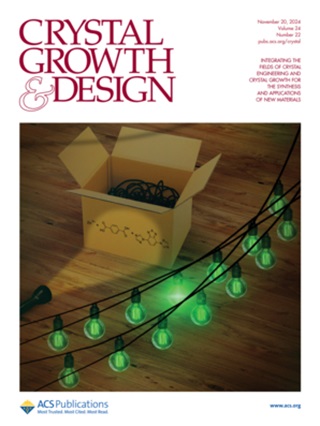Synthesis, Crystal Structure, and Magnetic Properties of Polynuclear Salamo Ni(II) Complexes
IF 3.2
2区 化学
Q2 CHEMISTRY, MULTIDISCIPLINARY
引用次数: 0
Abstract
Four distinct polynuclear Ni(II) complexes, namely [Ni2L2(py)2] (1), [Ni3L2(μ3-OAc)2]·4CH3CN (2), [Ni4L2(μ2-OAc)2(μ3-OMe)2(H2O)2]·MeOH (3), and [Ni7L3(μ3-OMe)2(μ3-OH)6(MeOH)6] (4), have been synthesized and characterized based on the salamo Schiff base ligand H2L. Ultraviolet–visible titration experiments and time-dependent density functional theory calculations elucidated that different reaction conditions (solvents and the metal–ligand molar ratio) result in the formation of these polynuclear structures. Magnetic investigations revealed the presence of intramolecular ferromagnetic coupling between Ni(II) centers in complexes 2–4.

多核Salamo Ni(II)配合物的合成、晶体结构和磁性能
以salamo Schiff碱配体H2L为基础,合成了[Ni2L2(py)2](1)、[Ni3L2(μ3-OAc)2]·4CH3CN(2)、[Ni4L2(μ2-OAc)2(μ3-OMe)2(H2O)2]·MeOH(3))和[Ni7L3(μ3-OMe)2(μ3-OH)6(MeOH)6](4)四个不同的多核Ni(II)配合物,并进行了表征。紫外可见滴定实验和随时间变化的密度泛函理论计算表明,不同的反应条件(溶剂和金属与配体的摩尔比)会导致这些多核结构的形成。磁性研究表明配合物2-4中Ni(II)中心之间存在分子内铁磁耦合。
本文章由计算机程序翻译,如有差异,请以英文原文为准。
求助全文
约1分钟内获得全文
求助全文
来源期刊

Crystal Growth & Design
化学-材料科学:综合
CiteScore
6.30
自引率
10.50%
发文量
650
审稿时长
1.9 months
期刊介绍:
The aim of Crystal Growth & Design is to stimulate crossfertilization of knowledge among scientists and engineers working in the fields of crystal growth, crystal engineering, and the industrial application of crystalline materials.
Crystal Growth & Design publishes theoretical and experimental studies of the physical, chemical, and biological phenomena and processes related to the design, growth, and application of crystalline materials. Synergistic approaches originating from different disciplines and technologies and integrating the fields of crystal growth, crystal engineering, intermolecular interactions, and industrial application are encouraged.
 求助内容:
求助内容: 应助结果提醒方式:
应助结果提醒方式:


